Explorations of HORIGUCHI Sutemi:Modernism, Rikyu, Garden, Waka
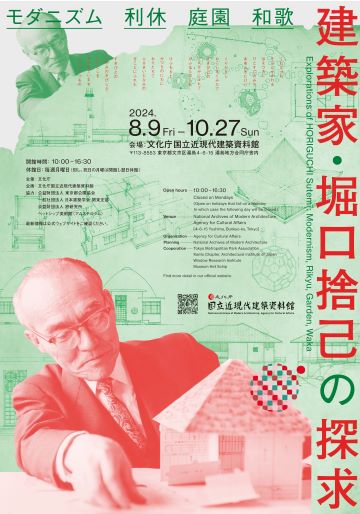 |
2024.8.9 Fri. -10.27 Sun. |
|---|
“Explorations of HORIGUCHI Sutemi:Modernism, Rikyu, Garden, Waka” was end.
Overview(Translation of the text in pamphlet)
Architect HORIGUCHI Sutemi (1895-1984) played a central role in the formation of the Bunriha Kenchiku Kai (1920s), the first authentic modern architectural movement in Japan. In the 1930s, he realized some of the leading works of International Style architecture in Japan. In addition to his early understanding of modern architectural trends in the west, he undertook superlative research on Japanese teahouses and sukiya-style architecture. After the Second World War, his implementation of modern sukiya-style architecture was highly influential. From the 1920s to the 1970s, HORIGUCHI was a leading architect in the Japanese architectural world. His deep insight into both modern architecture and traditional Japanese architecture made him an exceptional architect. Well versed in the tea ceremony and waka poetry, his creativity was not limited to the design of architecture and gardens, but encompassed a wide range of genres. Here, we can see the fruits of HORIGUCHI’s uncommon spirit of inquiry and creativity.
Through the display of original drawings of exemplary works from his student days through to his later years, as well as photographs he took during a tour of Europe in the 1920s, items from the Bunriha exhibition, material from his surveys of teahouses and gardens, and a full-size replica of a teahouse based on HORIGUCHI’s publication, this exhibition comprises a comprehensive introduction to the architecture, thinking, and creative world of architect HORIGUCHI Sutemi.
Basic Information
-
- Organization:Agency for Cultural Affairs
- Planning:National Archives of Modern Architecture
- Cooperation:Tokyo Metropolitan Park Association
- Kanto Chapter, Architectural Institute of Japan
- Window Research Institute
- Museum Het Schip
- Venue:National Archives of Modern Architecture, Agency for Cultural Affairs
- (4-6-15 Yushima, Bunkyo-ku, Tokyo)
- Date:2024.8.9 Fri. -10.27 Sun.
Closed:Mondays(Open on holidays that fall on a Monday. In which case the following day will be closed: Open on 12th Aug., 16th Sep., 23rd Sep., 14th Oct. Closed on 13th Aug., 17th Sep., 24th Sep., 15th Oct.)
Some of exhibits will be changed during the exhibition period.
- Open hours:10:00-16:30
Contents
1: Bunriha Kenchiku Kai and the Influence of Expressionism 1920–1929
Bunriha Kenchiku Kai, The Tokyo Peace Exibition, Koide House, Shienso, Soshokyo

Bunriha Kenchiku Kai, Bunriha Kenchiku Kai Manifesto and Works, Published by Iwanami Shoten|Illustrated by HORIGUCHI Sutemi|1920

Shienso Plans and Elevations|Date Unknown
2: Devotion to the International Style 1930–1939
Kikkawa House, Okada House, Oshima Island Weather Station, Wakasa House, Competition of Chureito Memorials to War Dead

Kikkawa Residence Perspective Drawing|1925
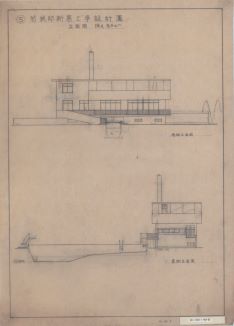
Wakasa Residence Elevations|Date Unknown
3: Searching for “Japan” 1936–1958
Growing Interest in Teahouse, Actual Suevey of Teahouse, Hashokan Yagotomise

Surveyed Drawing of Tai-an Teahouse, Myoki-an|1936
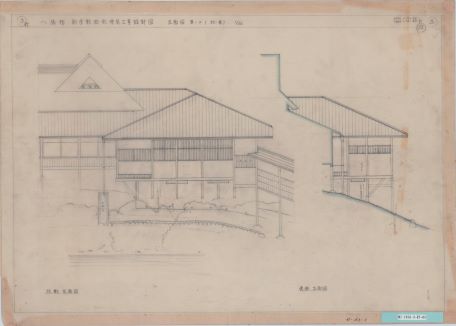
Hashokan Sakura no ma Elevations|1956
4: Transcending boundaries between tradition and modernity 1954–1984
Japanese Pavilion for Sao Paulo Exposition, Manyo Park, Manyo-kan, Manyo-tei, Shizuoka Futaba Gakuen, Tokoname Ceramics Research Institute, Seikei-an Teahouse
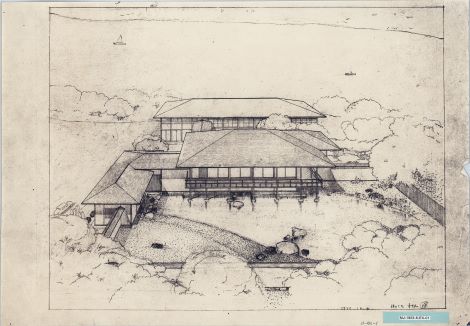
Japanese Pavilion for Sao Paulo Exposition Perspective Drawing|1953
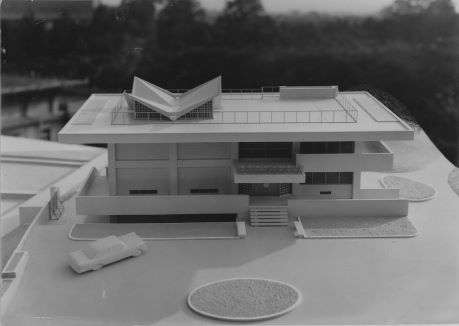
Tokoname Ceramics Research Institute, Model Photography|Date Unknown
Event Information
National Archives of Modern Architecture [NAMA], Agency of Cultural Affairs, will be hosting a gallery lecture by Alice Roegholt, founder and emeritus director of the Het Ship Museum, which produced the Video “Horiguchi Sutemi and the Amsterdam School,” currently on show in our exhibition room.
She will talk about the new discoveries she made during her research in Amsterdam about the exchange between Japan and the Netherlands in the field of architecture that took place over 100 years ago through the architect Sutemi Horiguchi.
Date Oct.18, 16:30-17:30
Title 1923: Horiguchi meets the Amsterdam SchoolLecturer Alice Roegholt, founder and emeritus director of the Het Schip Museum
Seat 30
Venue Exhibition Room, NAMA
Cooperation The Japan and Netherlands Architecture & Culture Association
Sponsor The Embassy of the Kingdom of the Netherlands in Japan
*This is a visual lecture using slides in English. Japanese summary will be distributed.
*Reservations are not required. Those who wish to attend should enter through the main gate of the Yushima Local Common Government Offices, do not enter via the Kyu-Iwasaki-tei Gardens, because the garden entrance will be closed at the end of the lecture.
